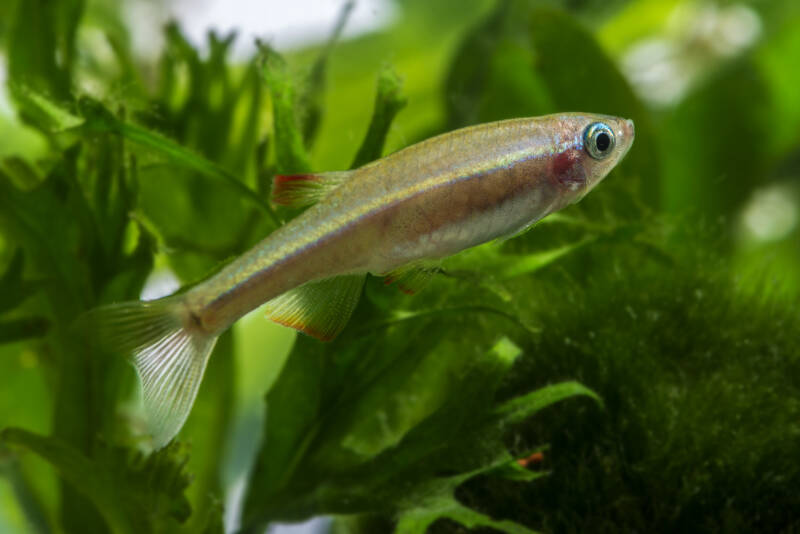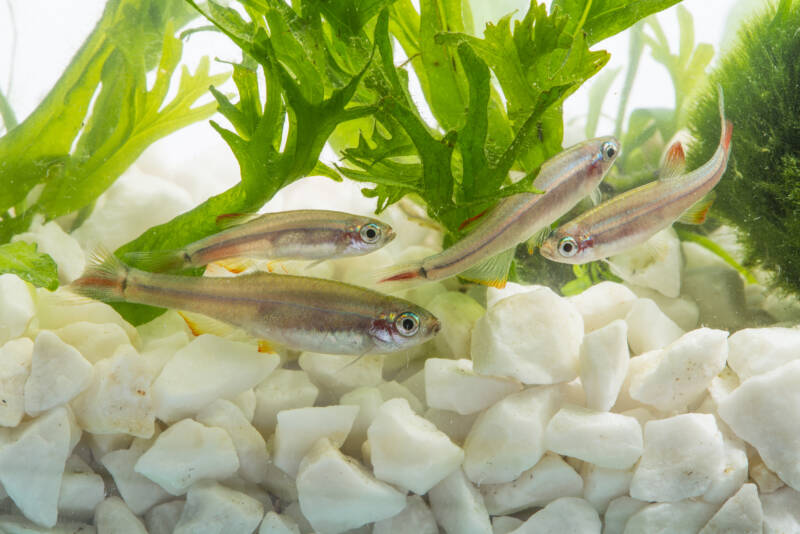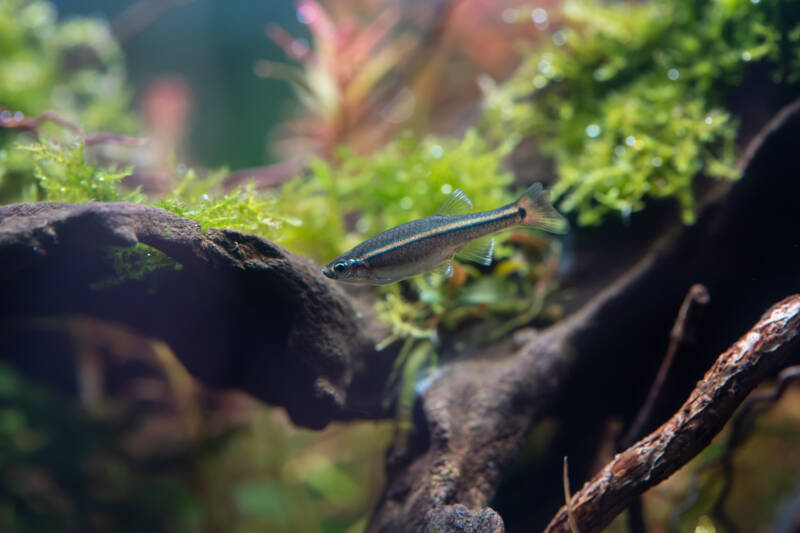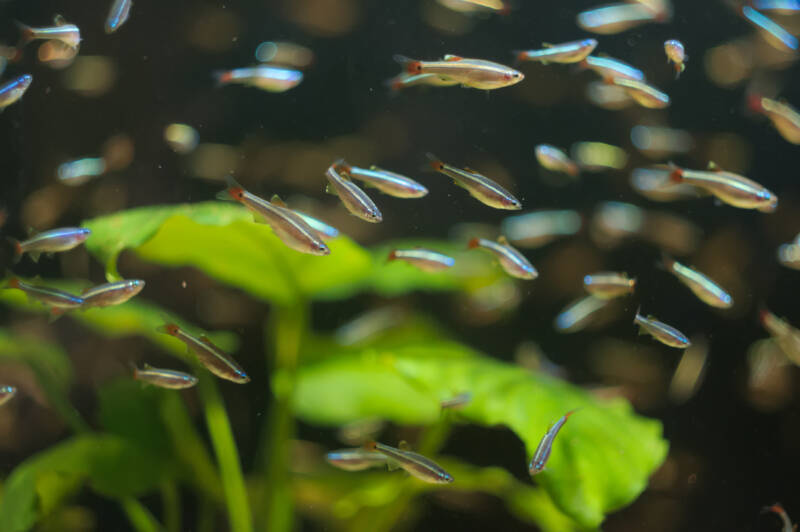Are you searching for an easy-to-care-for freshwater fish? Look no further than the White Cloud Mountain minnow!
This charming fish is both peaceful and sociable, making it an excellent addition to any community tank.

As a hardy member of the carp family, the White Cloud is a long-lived and peaceful fish that gets along well with others of its kind and multiple other species. They thrive in shoals and can add a burst of liveliness to your tank.
Caring for White Clouds is a breeze, as they are easy to feed and maintain. They require minimal care and attention, making them an excellent choice for beginner fishkeepers.
Discover more about this species, keep reading!
At a Glance
| Tank Size: | 10 gallons |
| Group Size: | Five or more |
| Water Temperature: | 57 to 72 degrees F (14 to 22 C) |
| pH: | 6.0 to 8.5 (6.8 to 7.5 preferred) |
| Hardness: | 2 to 15 dKH |
| Lifespan: | 5 to 7 years |
| Breeding: | Egg spawning |
| Adult Size: | 1.2 to 1.6 inches (3 to 4 cm) |
| Usual Place in the Tank: | Middle to top |
[toc]
Natural Habitat
The White Cloud Mountain minnow (Tanichthys albonubes) is a native of the Pearl River in the Guangdong Province of China.
Hailing originally from shallow, clear mountain streams, this species is considered endangered, and in fact, was thought to be extinct for several years.
While its natural habitat has degraded over time due to tourism and pollution, this species has thrived in the aquarium trade and is useful in controlling mosquito populations.
The White Cloud’s natural habitat includes a rocky substrate, slow to moderately flowing water that is slightly acidic, and plenty of aquatic plants and algae.
This species uses underwater vegetation for both shelter and breeding.
Appearance and Biology

Thin and tapering, the White Cloud has a sleek shape.
The fish’s dorsal and ventral fins sweep backward toward the tail. These fins can appear triangular-shaped or slightly rounded.
This fish can appear in a range of colors. Most common is silver-green, with splashes of red on their nose and fins.
The fins can also have touches of white and areas of transparency. A black dot appears at the base of the caudal fin.
Along the lateral line of the body, there are two horizontal stripes, one black, and one white/pink.
Other color combinations you may see are gold with blue stripes or cream with white stripes.
Another long-finned variant of this fish has elongated fins and a deep red hue.
Sexing
If you look closely, you can determine the differences between male and female White Clouds.
The males usually sport brighter colors and a slimmer body.
Size

When you first purchase your White Cloud Mountain minnows, they may be as small as 0.5 to 1 inch (1.3 to 2.5 cm).
As they grow to adult size, they will reach between 1.2 and 1.6 inches (3 to 4 cm).
Because these fish are so tiny, you can get away with smaller tank sizes.
Lifespan
This little fish will be around for a while in your home aquarium. Their lifespan is from five to seven years.
As always, proper diet and tank maintenance are very important to ensuring a long lifespan for your fish.
Most important is maintaining proper water temperature and conditions.
Behavior
You will love both the peaceful nature and beautiful coloration of these fish.
They are very active, preferring to swim and feed in the top and middle areas of the tank, but will explore the bottom areas, too.
A shoaling fish, the White Cloud does best in groups of at least five to eight.
If your tank size can accommodate a larger group, even better, as they will be more comfortable and active.
They can be a joy to feed as the group may come together at mealtimes.
This fish thrives in a community tank and gets along well with other small, similarly tempered fish and invertebrates.
The only time you will see aggression from the White Cloud is during mating, when males establish territory to attract mates.
How many per gallon?
Up to five White Cloud Mountain minnows can be kept in a 10-gallon minimum tank size.
Plan on two additional gallons of water for each additional minnow.
Tank Setup
Decorations
The White Cloud’s natural habitat features streams with rocky substrate.
To simulate this in your tank, line the bottom with gravel. Include some larger pebbles and rocks.
Driftwood is another option to give your fish places to hide.

Feel free to add a variety of live plants to the tank.
Arrange the plants so that there is an open swimming space. Some favorites are:
- Hornwort
- Water sprite
- Dwarf rotala.
Any floating plants that you add, such as duckweed or pondweed, should not over crowd the water surface.
Water Conditions
As we have mentioned, water temperature is key to keeping this species healthy.
Your tank should sit at a temperature range between 57- and 72-degrees Fahrenheit (14 to 22 degrees C); if possible, keep it closer to 64 degrees.
Although the fish can tolerate the higher ranges of tropical fish tanks, these temperatures significantly impact the health and lifespan of the fish.
Keep the pH range between 6.0 and 8.5; however, if you can keep it closer to between 6.8 and 7.5, that is ideal.
Make sure the tank water is cycled before you add your fish. The water hardness should be between 2 and 15 dKH.
Equipment
There are not many equipment needs when keeping White Cloud Mountain minnows.
First, when purchasing a tank, look for one with a well-fitting cover or hood. These active fish have been known to jump out.
Next, to keep the current gentle in the tank, consider installing an under gravel filter or other filters with a low flow rate.
Keep the tank lighting lower and install a thermometer to keep on top of water temperature.
Tank Mates

The ideal tank mates for the White Cloud Mountain minnow are smaller, peaceful species that are accustomed to cooler waters.
Consider the following to pair with your White Cloud Mountain minnows:
- Smaller gobies, such as Stiphodon
- Loaches (hillstream, weather, dojo, and horseface)
- Gouramis (paradise fish or dwarf gourami)
- Barbs (golden, cherry, Odessa, and rosy)
- Danios, such as the zebra
- Corydoras catfish
- Shrimp or snails.
Avoid the following:
- Barbs, if you are keeping the Meteor minnow variation of the White Cloud. The barbs will be tempted to nip the minnow’s long fins.
- Aggressive loaches, such as the clown loach
- Aggressive barbs, such as the tiger barbs
- Cichlids.
Food and Diet
White Clouds are predatorial feeders. In their natural environment, they feast mainly on live foods, such as insect larvae, brine shrimp, and zooplankton.
Keep their diet as close to natural as possible using a base of high-quality flake food paired with live or frozen foods and a few greens.
The ideal flake foods should be high in protein and vegetable content.
Your White Cloud will readily eat:
- Artemia
- Tubifex
- Microworms
- Water fleas
- Brine shrimp
- Spirulina
- Alginate tablets.
Feed your fish two to three times daily and only enough that they can consume in a few minutes.
Breeding
Overall, there is not much you will need to do to breed your White Clouds.
Simply having a good mix of males and females and a separate breeding tank is the place to start.
Breeding Behavior
When White Clouds are ready to breed, you may notice that the males are showing brighter colors and the females have grown rounder.
You also may observe some aggressive, territorial behavior on the part of the males.
The fish will then pair off to breed. In the wild, these fish breed from March to October.
In captivity, they will spawn several times a year.
Tank Setup
You can breed your minnows in a species-only or community tank; however, setting up a separate breeding tank will reduce the chance of the eggs or fry being eaten by the adult fish.
Tank needs are minimal, and you can go as small as a 7-gallon tank if you wish.
Add moss, plants, or a spawning mop. The female will scatter her eggs around these objects.
Keep the water temperature in the range of 64 to 72 degrees Fahrenheit and feed your fish high protein foods three times a day. Some favorites are tubifex and brine shrimp.
Caring for the Fry
Once the eggs are laid and fertilized, remove the parents from the breeding tank.
Expect to see the eggs hatch in about two days.
The newborn fry will feed off their yolk sacs at first. As they become free swimming, you can feed them infusoria, then graduate to baby brine shrimp or micro-worms as they get bigger.
At six months old, the fish are mature and ready for the community tank.
Hardiness
The White Cloud Mountain minnow is a hardy fish.
However, there is one ailment to look out for with this species – streptococcus infection.
They can be more prone to the infection if your tank is poorly maintained.
The bacterial infection is very contagious, can spread quickly, and can be fatal if left untreated.
You will notice that fish infected with streptococcus cannot swim correctly, may not be able to keep themselves upright, and may sink toward the bottom of the tank.
Remove any fish exhibiting these behaviors right away and consult a veterinarian.
Frequently Asked Questions
1. Can White Cloud minnows live in a tropical tank?
Technically, yes, but they do not thrive in warmer water tanks.
Placing your White Clouds in a tropical tank will stress them considerably and reduce their lifespan.
2. How long do White Cloud Mountain minnows live?
With proper care and upkeep of tank conditions, White Clouds can live for anywhere from five to seven years.
3. What do White Cloud Mountain minnows eat?
White Cloud minnows love live foods. In an aquarium setting, some of their favorites are larvae, brine shrimp, and tubifex.
They will eat these live or frozen, in addition to flake foods and vegetables.
4. Do White Cloud minnows need a heater?
Not really. They prefer the water colder than the tropical fish found in most aquariums.
5. How often should you feed White Cloud minnows?
Feed your White Cloud minnows two to three times per day.
6. How long can White Cloud minnows go without food?
While most healthy fish can go up to a week without food, we recommend you feed your White Cloud minnows at least twice daily.
Final Recommendations
Hardy and easy to care for, the White Cloud Mountain minnow is a great choice as a starter fish for a beginner or for the experienced aquarium keeper.
They are a peaceful species, get along with others well in a community tank, and shoal in beautifully colored groups.
Maintain the water quality and temperature for these little fish, and they will be around a long time for your enjoyment.
These fish cost from $1 to $2 per fish. Remember, you will want to purchase at least five so that they have the comfort of a group.
Have you had success with keeping a group of White Cloud Mountain minnows?
We would love to hear about your preferred aquarium setup!
